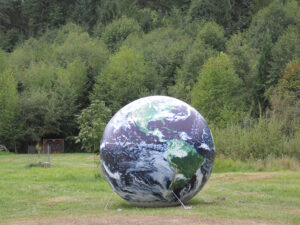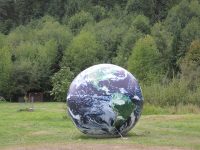
Excerpted from the Spring 2019 edition of Communities, “Community Land”—full issue available for download (by voluntary donation) here.
This issue focuses on a key area of intentional community: the relationship of groups to the land on which they live and make their homes. While this is particularly important for rural communities, the question of who owns (or purports to own), controls, and/or stewards the ground under our feet affects every intentional community, even the most urban one. That being said, the articles in this issue focus mostly on more consciously land-based communities―as opposed to those occupying, for example, yard-less urban developments or apartment buildings.
In many ways, Land and Community cannot be separated. Access to land depends on interactions and negotiations with other human beings; effective organizing to gain access to land depends on “community” in one form or another. This social dimension to land access is a double-edged sword: most of us reading this magazine are living on land that was long ago stolen from its indigenous inhabitants via very effective organized efforts (facilitated by, as Jared Diamond has pointed out, the capacity of cultures with “guns, germs, and steel” to overwhelm cultures without them). This same social/economic/political dimension to land access proves an obstacle to any less-privileged or marginalized group which wants to gain or regain access to land.
Yet this equation can be reversed, and land can also become accessible through our own collective, organized efforts. Most of the articles in this issue are dedicated to showing how―as well as to exploring the complex issues surrounding land, people, privilege, and how to achieve greater equity and sustainability in our relationship to land.
And just as access to land depends on community in some form, community often depends on and derives its vitality from a group’s relationship to land. This is the other major thread running through this issue, whose overarching theme might be the interdependence of our selves, our human communities, and the lands which steward (and hopefully are stewarded by) our presence.
● ● ●
Readers will notice a few changes in this issue. We’ve slightly increased font sizes, leading, and margins, as well as attention to graphic relief on article pages. It is still a packed issue―we hope just as full of valuable material while also being more accessible and attractive. We’ve sacrificed the equivalent of an article or two by making these layout adjustments, but we’re happy with the trade-off. To put things in perspective, every issue of Communities would fill a standard-dimension book exceeding 200 pages (including illustrations) if laid out in a typical book format. We always welcome your feedback on these layout changes or any other aspect of the magazine.
Our next issue will announce some other exciting changes within the larger FIC organization. Please stay tuned!
● ● ●
Finally, we want to thank all of you who supported (through the crowdfunding campaign that launched it a year ago), purchased, and helped spread the word about our four-volume Wisdom of Communities book set. Those who have early copies of Volume 4 now own a collector’s item―we discovered recently that, due to an optical illusion, “Sustainability” on the front cover is spelled without the final “i.” That mistake has now been corrected. The lesson? Perhaps that proper “Sustainability” is even more elusive than we’ve come to think―that even what appears to be sustainability may not be. True sustainability may require a third I/eye. We’re sure more lessons can be derived from this episode, but meanwhile, we believe that many more lessons can be derived from the books themselves―still available for order at ic.org/wisdom.
● ● ●
This issue, like the four that preceded it, is available as a free or by-donation digital download here: Issue 182. Please tell others about this magazine and help us continue to serve the communities movement and the wider movement toward a more cooperative, just, and resilient world.
Community, land, and self need to be integrated once again in ways that can be continued for generations. We all can be part of that transition.
Chris Roth edits Communities and calls Lost Valley/Meadowsong Ecovillage in western Oregon home.
Excerpted from the Spring 2019 edition of Communities, “Community Land”—full issue available for download (by voluntary donation) here.
















